#i mostly use the translator to make some sentences sound less “broken” and connect parts better together but im able to come up with
Explore tagged Tumblr posts
Text
SA SAMAR
May 4-8, 2018 - ��Nasaan na raw po ‘yung mga paintings ni daddy?” (Where are my daddy’s paintings?)
The lack of Waray words in the sentence might’ve encouraged my grandmothers to ignore my inquiry once again. Still, I insist—I cannot let down my dad’s excitement and mine, too. It was my first time in Samar, and right after setting my foot in the tiny Tacloban airport, I knew it was going to be a special experience. It must have been different for them, though. I am just their (literally) distant granddaughter who visited the province for the first time as a representative of my dad, the young man who left his hometown in his 20s and hasn’t come back since.
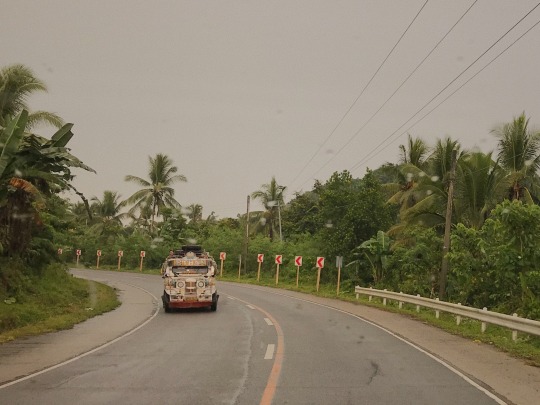
Western Samar, 2018
I traveled to Samar for a 5-day vacation with my two Waray Balikbayan aunties. What they spoke of 60% of the time, I have no clue! Upon landing at Tacloban, we immediately embarked on a 5-hour drive from the airport to my grandmother’s humble home. I’m all groggy and tired, but I can’t waste those 5 hours of stories and beautiful scenery by sleeping.
My aunts hired a local driver and they exchanged short anecdotes on the life of Yolanda survivors after the great Typhoon, the freshness of seafood and vegetables in Samar, the perfect places to buy pasalubongs, etc. I struggle to keep myself in the conversation, asking them to translate in Tagalog a sentence or two.

San Juanico Bridge, 2018
The ride started from souvenir shops, gasoline stations, and small parks, to tall palm trees, an overlooking of the shore, and of course, the Samar-Leyte connection—San Juanico Bridge—and its good-looking view. Serene and beautiful. Not until we noticed the recurring view of identical half-made houses that seemed to be under construction AND abandoned. They were the pabahay (housing) for the victims of Typhoon Yolanda.
Our local driver narrated the current situation of the pabahays. It is a worry that most of the houses can comfortably accommodate only at most 3 people. But, it is even more problematic that most of them currently accommodate less than they can—none—because they are not even halfway done. See, Typhoon Yolanda happened almost 5 years ago.
On a positive note, it is a relief to know that there are housings of good quality provided mostly by the NGOs and other donors. They are medium-sized, beautifully-painted, and some are even equipped with a satellite dish. :)
SAN PEDRO

San Pedro, Quinapondan, Eastern Samar, 2018
My grandmother and Aunt Baby, the sweetest of them all, welcomed us with a big hug and a feast of seafood, vegetables, root crops, and meat. Freshness beyond words. We ate together with our hands, and called to meal whosoever happens to pass by the dining area. It was a feast! I can still remember how my hungry, jet-lagged self devoured that meal. Jollibee is no match. Sobrang sarap talaga huhu

San Pedro, Quinapondan, Eastern Samar, 2018
A mini "welcome tour" from my Aunt Baby followed afterward. Meeting my cousins that day was like meeting them for the first time. We were kids when we last spent time together. My cousins smiled shyly and said nothing as my Aunt Baby called them from their rooms. If their eldest sister--who was of my age--was there, it might have been different.
My Aunt Baby's eldest son tagged along as she led me to the shabby stairs of a bahay kubo across my grandmother's house. The bahay kubo was old and fully furnished, but spacious. It housed relatives I've never met until then: my father’s cousins, their children, and their blind mother—one of my grandmothers. All narrated childhood stories of them and my dad’s. Happy stories, until they get to the part where my daddy left.
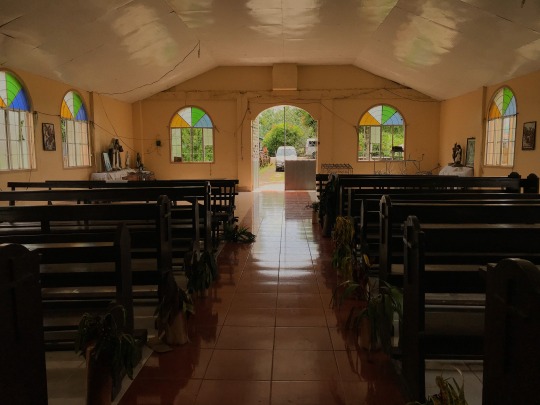
San Pedro Church, Quinapondan, Eastern Samar, 2018

San Pedro Church, Quinapondan, Eastern Samar, 2018 | Fujicolor C200 in Canon TLb
From afar, San Pedro Church looked like a typical province church. Beautiful and small. Up close, it was of dried flowers, broken pews, shattered glass panes, and severed holy statues. I wonder how a church, that stands in the middle of a Barangay, filled with (probably) very religious people, can look so neglected. We said our prayers, and left.
CALICOAN ISLAND

Calicoan Island, Guiuan, Eastern Samar, 2018 | Fujicolor C200 in Canon TLb

Calicoan Island, Guiuan, Eastern Samar, 2018

Calicoan Island, Guiuan, Eastern Samar, 2018
The moment we arrived, it was low tide. Nevertheless, the Island was beautiful. For someone as easily fascinated as myself, I am in awe. (as usual) I don't have much to say about Calicoan, except that it makes me feel like leaving the City life for good.
Traveling with people who are from a different generation means I have to do my millennial shit alone. And so, that day, as my elders are chitchatting and trying to avoid the sun and the sea, I put on my bathing suit, went down the beach, set up my phone camera beneath the rocks, and took videos and photos of myself along the shore.
Sounds lonely, but it was refreshing.
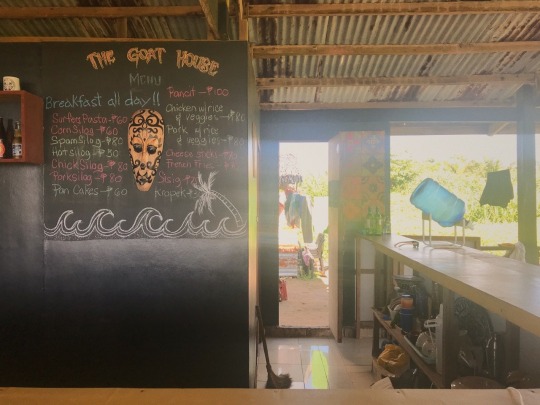
The Goat House, Calicoan Island, Guiuan, Eastern Samar, 2018
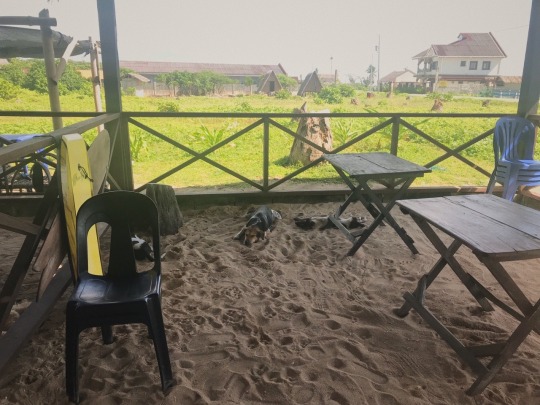
The Goat House, Calicoan Island, Guiuan, Eastern Samar, 2018
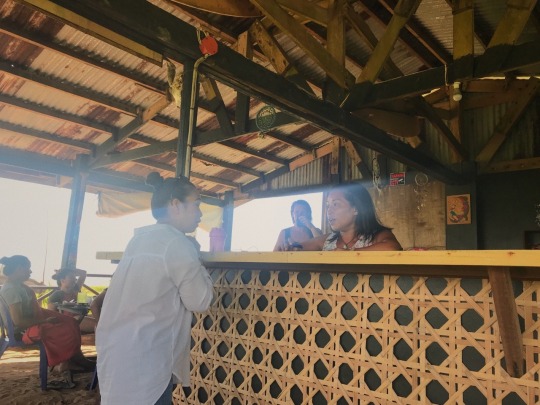
The Goat House, Calicoan Island, Guiuan, Eastern Samar, 2018
A few steps away from Calicoan Resort is a surfing spot called ABCD Beach, and across that beach is a small eating place for surfers called The Goat House. I urged my Aunt to try their food, which I had high hopes for. Not as good as I hoped, but the stories we heard inside The Goat House made up for it.
The eatery was manned by 2 locals and a French traveler, the girlfriend of one of the locals. The 32-year-old French waitress served our food, along with the story of the surfing scar on her leg--upon asking. Her travel story followed right after. She was really brave.
Another foreign traveler sits by the wooden bar. The Dutch surfer/customer enthusiastically answered my Aunt's inquiry: "So how's the Philippines?" with very lovely, positive words. It’s a shame that they might’ve experienced the Philippines more than I do. Before leaving, we finished a kakanin that one of my uncles ordered from a vendor by the road. Despite the food, I have no regrets about visiting the place.
SULANGAN

St. Anthony of Padua Parish, Sulangan, Guiuan, Eastern Samar, 2018 | Fujicolor C200 in Canon TLb

St. Anthony of Padua Parish, Sulangan, Guiuan, Eastern Samar, 2018 | Fujicolor C200 in Canon TLb

St. Anthony of Padua Parish, Sulangan, Guiuan, Eastern Samar, 2018 | Fujicolor C200 in Canon TLb
This is a corner dedicated for offering prayers to St. Anthony of Padua. As expected, it was filled with Catholic tourists lighting their candles. I waited long for the area to clear up to get a shot. However, as I finally take the long-awaited shot, a man in short bobs and worn-out gloves replaced the group of praying people. He was patiently clearing out the candle drops and leftover wax before another set light new ones. I gladly included him in the frame. Only to find out weeks later that my shot was out of focus. Even so, I enjoyed the people-watching.
SAN PEDRO, AGAIN

San Pedro, Quinapondan, Eastern Samar, 2018

San Pedro, Quinapondan, Eastern Samar, 2018
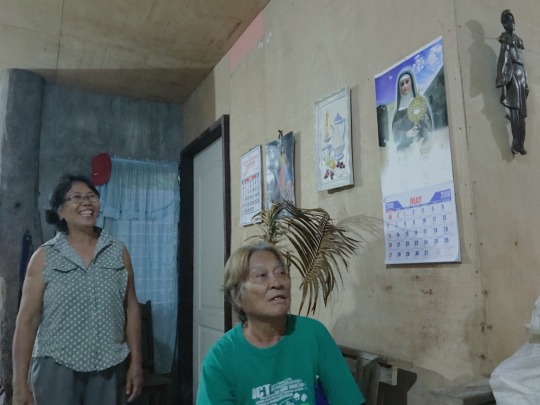
San Pedro, Quinapondan, Eastern Samar, 2018
It was a mini recap of my dad’s childhood, before finally leaving Samar. I saw the house and the woman--his aunt--who raised my dad. They told me lots of stories, and were very warm. I love old stories by old people.
While my dad was on video call, I looked around the house for the paintings that he was bragging about ever since I landed. This has to be the highlight of my trip--nothing’s more interesting, so far, than my father’s long lost art! Finding nothing, I inquired once again:
“Nasaan na raw po ‘yung mga paintings ni daddy?”
(Where are my daddy’s paintings?)
I got my answer.
“Wala na, natangay ng Yolanda.”
(None are left, they are taken away by (Typhoon) Yolanda.)
For a while there, I was devastated. I could sense my dad was too. So, I let him talk to his old friends and family. He was laughing the whole time, despite the weak signal, pixelated faces, and slurry words.
At that moment, I decided I should go back soon. I’ll be with dad. He will be coming home, too.
--‘Till next time!
3 notes
·
View notes
Text
Three Writing Rules to Disregard
New Post has been published on https://writingguideto.com/trending/three-writing-rules-to-disregard/
Three Writing Rules to Disregard
I have nothing against rules. They’re indispensable when playing Monopoly or gin rummy, and their observance can go a long way toward improving a ride on the subway. The rule of law? Big fan.
The English language, though, is not so easily ruled and regulated. It developed without codification, sucking up new constructions and vocabulary every time some foreigner set foot on the British Isles—to say nothing of the mischief we Americans have wreaked on it these last few centuries—and continues to evolve anarchically. It has, to my great dismay, no enforceable laws, much less someone to enforce the laws it doesn’t have.
Certain prose rules are essentially inarguable—that a sentence’s subject and its verb should agree in number, for instance. Or that in a “not only x but y” construction, the x and the y must be parallel elements. Why? I suppose because they’re firmly entrenched, because no one cares to argue with them, and because they aid us in using our words to their preeminent purpose: to communicate clearly with our readers. Let’s call these reasons the Four C’s, shall we? Convention. Consensus. Clarity. Comprehension.
Also simply because, I swear to you, a well-constructed sentence sounds better. Literally sounds better. One of the best ways to determine whether your prose is well constructed is to read it aloud. A sentence that can’t be readily voiced is a sentence that likely needs to be rewritten.
A good sentence, I find myself saying frequently, is one that the reader can follow from beginning to end, no matter how long it is, without having to double back in confusion because the writer misused or omitted a key piece of punctuation, chose a vague or misleading pronoun, or in some other way engaged in inadvertent misdirection. (If you want to puzzle your reader, that’s your own business.)
As much as I like a good rule, I’m an enthusiastic subscriber to the notion of “rules are meant to be broken”—once you’ve learned them, I hasten to add.
But let’s, right now, attend to a few of what I think of as the Great Nonrules of the English Language. You’ve encountered all of these; likely you were taught them in school. I’d like you to free yourself of them. They’re not helping you; all they’re doing is clogging your brain and inciting you to look self-consciously over your own shoulder as you write, which is as psychically painful as it is physically impossible. And once you’ve done that, once you’ve gotten rid of them, hopefully you can put your attention on vastly more important things.
Why are they nonrules? So far as I’m concerned, because they’re largely unhelpful, pointlessly constricting, feckless, and useless. Also because they’re generally of dubious origin: devised out of thin air, then passed on till they’ve gained respectable solidity and, ultimately, have ossified. Language experts far more expert than I have, over the years, done their best to debunk them, yet these made-up strictures refuse to go away and have proven more durable than Keith Richards and Mick Jagger. Put together. Part of the problem, I must add, is that some of them were made up by ostensible and presumably well-meaning language experts in the first place, so getting rid of them can be a bit like trying to get a dog to stop chasing its own tail.
I’ll dispatch these reasonably succinctly, with the hope that you’ll trust that I’ve done my homework and will be happy to see them go. I’m mindful of Gertrude Stein’s characterization of Ezra Pound as “a village explainer, excellent if you were a village, but if you were not, not,” and no one wants to be that guy. Also, if you persist in insisting that these nonrules are real and valid and to be hewed to, all the expert citations in the world won’t, I know through experience, change your mind one tiny little bit.
An admission: Quite a lot of what I do as a copy editor is to help writers avoid being carped at, fairly or—and this is the part that hurts—unfairly, by People Who Think They Know Better and Write Aggrieved Emails to Publishing Houses. Thus I tend to be a bit conservative about flouting rules that may be a bit dubious in their origin but, observed, ain’t hurting nobody. And though the nonrules below are particularly arrant nonsense, I warn you that, in breaking them, you’ll have a certain percentage of the reading and online-commenting populace up your fundament to tell you you’re subliterate. Go ahead and break them anyway. It’s fun, and I’ll back you up.
1. Never Begin a Sentence with “And” or “But.”
No, do begin a sentence with “And” or “But,” if it strikes your fancy to do so. Great writers do it all the time. As do even not necessarily great writers, like the person who has, so far in this essay, done it a few times and intends to do it a lot more.
But soft, as they used to say, here comes a caveat:
An “And” or a “But” (or a “For” or an “Or” or a “However” or a “Because,” to cite four other sentence starters one is often warned against) is not always the strongest beginning for a sentence, and making a relentless habit of using any of them palls quickly. You may find that you don’t need that “And” at all. You may find that your “And” or “But” sentence might easily attach to its predecessor sentence with either a comma or a semicolon. Take a good look, and give it a good think.
Let’s test an example or two.
Francie, of course, became an outsider shunned by all because of her stench. But she had become accustomed to being lonely.
Francie, of course, became an outsider shunned by all because of her stench, but she had become accustomed to being lonely.
Which do you think Betty Smith, the author of A Tree Grows in Brooklyn, chose? The former, as it happens. Had I been Smith’s copy editor, I might well have suggested the second, to make one coherent, connected thought out of two unnecessarily separated ones. Perhaps she’d have agreed, or perhaps she’d have preferred the text as she’d written it, hearing it in her head as a solemn knell. Authors do often prefer their text the way they’ve written it.
Here’s another, in two flavors:
In the hospital he should be safe, for Major Callendar would protect him, but the Major had not come, and now things were worse than ever.
In the hospital he should be safe, for Major Callendar would protect him. But the Major had not come, and now things were worse than ever.
This is E. M. Forster, in A Passage to India, and I suspect you’ll not be surprised to learn that version 2 is his. For one thing, version 1’s a bit long. More important, version 2, with that definitive period, more effectively conveys, I’d say, the sense of dashed expectations, the reversal of fortune.
These are the choices that writers make, and that copy editors observe, and this is how you build a book.
One thing to add: Writers who are not so adept at linking their sentences habitually toss in a “But” or a “However” to create the illusion that a second thought contradicts a first thought when it doesn’t do any such thing. It doesn’t work, and I’m on to you.
2. Never Split an Infinitive.
To cite the most famous split infinitive of our era—and everyone cites this bit from the original Star Trek TV series, so zero points to me for originality—“To boldly go where no man has gone before.”
There’s much more—much more—one could say on the subject, but I don’t want to write about the nineteenth-century textual critic Henry Alford any more than you want to read about the nineteenth-century textual critic Henry Alford, so let’s leave it at this: A split infinitive, as we generally understand the term, is a “to [verb]” construction with an adverb stuck in the middle of it. In the Star Trek example, then, an unsplit infinitive version would be “Boldly to go where no man has gone before” or “To go boldly where no man has gone before.” If either of those sounds better to you, be my guest. To me they sound as if they were translated from the Vulcan.
Otherwise, let’s skip right to Raymond Chandler. Again, as with the Star Trek phrase, everyone loves to cite Chandler on this subject, but it’s for a God damn [sic] good reason. Chandler sent this note to the editor of The Atlantic Monthly in response to the copyediting of an article he’d written:
By the way, would you convey my compliments to the purist who reads your proofs and tell him or her that I write in a sort of broken-down patois which is something like the way a Swiss waiter talks, and that when I split an infinitive, God damn it, I split it so it will stay split.
Over and out.
3. Never End a Sentence with a Preposition.
This is the rule that invariably (and wearily) leads to a rehash of the celebrated remark by Winston Churchill that Winston Churchill, in reality, neither said nor wrote:
“This is the kind of arrant pedantry up with which I will not put.”
Let me say this about this: Ending a sentence with a preposition (as, at, by, for, from, of, etc.) isn’t always such a hot idea, mostly because a sentence should, when it can, aim for a powerful finale and not simply dribble off like an old man’s unhappy micturition. A sentence that meanders its way to a prepositional finish is often, I find, weaker than it ought to or could be.
What did you do that for?
Why did you do that?
has some snap to it.
But to tie a sentence into a strangling knot to avoid a prepositional conclusion is unhelpful and unnatural, and it’s something no good writer should attempt and no eager reader should have to contend with.
If you follow me.
Benjamin Dreyer is vice president, executive managing editor, and copy chief of Random House. He began his publishing career as a freelance proofreader and copyeditor. In 1993, he became a production editor at Random House, overseeing books by writers including Michael Chabon, Edmund Morris, Suzan-Lori Parks, Michael Pollan, Peter Straub, and Calvin Trillin. He has copyedited books by authors including E. L. Doctorow, David Ebershoff, Frank Rich, and Elizabeth Strout, as well as Let Me Tell You, a volume of previously uncollected work by Shirley Jackson. A graduate of Northwestern University, he lives in New York City.
Excerpted with permission from the new book Dreyer’s English: An Utterly Correct Guide to Clarity and Style, by Benjamin Dreyer. Published by Random House, a division of Penguin Random House LLC, New York. Copyright © 2019 by Benjamin Dreyer. All rights reserved.
Source
Three Writing Rules to Disregard
0 notes